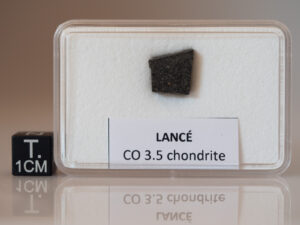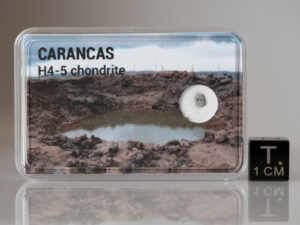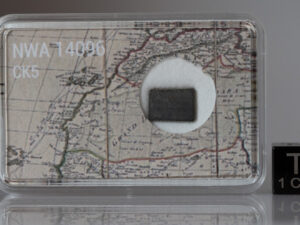Description
Saint-Pierre-le-Viger 49°49.255’N, 0°49.584’E
Seine-Maritime, Normandy, France
Confirmed fall: 2023 Feb 13
Classification: Ordinary chondrite (L5-6)
History: Asteroid 2023 CX1 was discovered on 12 February 2023, at 20:18:07 UTC by Hungarian astronomer Krisztián Sárneczky working at the Piszkéstető Station of Konkoly Observatory in the Mátra Mountains (Hungary). With the support of astronomers at Višnjan Observatory in Tičan (Croatia), he predicted that the 1-meter rock would collide with Earth’s atmosphere on 13 February 2023 at 2:59:21 UTC. Very soon after the event, the combination of telescope observations with those of amateur and professional cameras made it possible to determine that fragments of the asteroid that had survived the atmospheric passage had fallen in Normandy. Teams of the FRIPON/Vigie-Ciel project arrived on-site on the day following that of the the fall. Led by Observatoire de Paris, the FRIPON project consists of a camera network initiated in France to watch for incoming bolides, while the Vigie-Ciel citizen science project was designed by MNHNP to help recover meteorites on the ground. The teams comprised scientists from various institutions involved in the network (MNHNP, Observatoire de Paris, Université Paris-Saclay, Aix-Marseille Université, etc.), mediation professionals involved in the outreach actions of the program, amateurs and local residents recruited through the network and local communication. They contacted the mayors of the municipalities concerned, identified the owners of potentially interesting land, and obtained authorizations to search. The first systematic search was conducted on 15 February and, at 4.50 pm local time, the first stone (94 g) was found in the commune of Saint-Pierre-le-Viger by art student Loïs Leblanc-Rappe. The search continued in the days that followed, leading to the recovery of eleven more small stones (mass range 2-24 g) in the commune of Angiens. A number of meteorite hunters also arrived and recovered an unknown number of stones (presumed to be one or two dozen, with a total mass of several hundred g). Fieldwork for the FRIPON/Vigie-Ciel teams ended on 26 March, but leaflets were distributed in local mailboxes asking the inhabitants to inform the program of potential new finds. Contacts with the landowners are still ongoing as of today. All those who were asked generously agreed that the stones found on their property should become part of the French National Collection curated at MNHNP.
Petrography (L. Ferrière, NHMV; I. Baziotis, AUA; M. Gounelle, B. Zanda, and S. Pont, MNHNP): Two polished sections were analyzed. The sample exhibits a chondritic texture, locally brecciated, with clasts of petrologic type 5 and 6. Relict chondrules are scarce in the clasts (and competely lacking in some clasts) due to high petrologic type. The meteorite shows abundant fractures and melt veins (up to 100 µm thick) displaying cross-cutting relations to each other. It contains porphyritic and nonporphyritic chondrules. The scarce barred olivine chondrules have a shape with irregular to non-discernible edges. The rock consists mainly of olivine and low Ca-pyroxene (orthopyroxene), as well as plagioclase (up to 100 µm in size), rare high-Ca pyroxene, Fe-Ni metal, oxides (chromites), troilite, phosphates (apatite and merrillite), and rare grains of tetrataenite. Olivine and plagioclase show undulatory extinction. Weak mosaicism and planar fractures (but no PDFs) were observed in olivine grains. In addition to the numerous shocked veins, the high-pressure phase jadeite was found and confirmed (using micro-Raman spectroscopy) in one of them. All together these observations suggest a shock stage of C-S3. The fusion crust displays at least two distinct layers, and in places even three layers; the layers are composed by nicely formed quenched crystals.
Geochemistry (L. Ferrière, NHMV; I. Baziotis, AUA; M. Gounelle, B. Zanda, and S. Pont, MNHNP): Mineral composition by Electron Microprobe analyses. Olivine Fa25.17±0.42 (N=18); Orthopyroxene Fs21.51±0.39Wo1.63±0.18 (N=24); High-Ca Pyroxene Fs8.63±0.10Wo44.66±0.15 (N=4); Pagioclase An10.22Al84.1 (N=13); Sulfide: Ni <0.5 wt%. Kamacite with Ni in the range 5.6-6.3 wt% (N=2). Chromite with Mg# ranging from 9.9 to 14.0, Cr# from 80.2 to 81.1, and Ti# from 6.85 to 8.44. Physical characteristics: Magnetic susceptibility of 3.05 g full stone is log χ (× 10-9 m3/kg)=4.73 (J. Gattacceca, CEREGE).
Classification (L. Ferrière, NHMV, and I. Baziotis, AUA): Ordinary Chondrite (L5-6), C-S3, W0. This is based on the following criteria: 1) olivine Fa composition is restricted in the range 24.6-26.5; 2) mean Ni in sulfide is <0.5 wt%; 3) the abundance of the low-Ca pyroxene is mainly orthorombic; 4) deviation of olivine analyses from the average is <5%; and 5) few chondrules are visible in the investigated thin sections. Weathering stage: No visible oxidation, W0.
Specimens: The main mass (175.2 g) found by Steve Arnold in Fontaine-le-Dun is now owned by Bil Bungay who has deposited it permanently at MNHNP. 155g and a polished mount at MNHNP (94g fully crusted first stone found in Saint-Pierre-le-Viger and 61g in four fragments of the smashed Autigny stone). Status of the eleven other stones found in Angiens by the Vigie-Ciel teams (113 g in total) still to be decided with landowners. A 5.1 g fragment of the Autigny stone is at NHMV (NHMV-O2775) as well as a polished thin section (NHMV-O2776). 6.6 g of powder and small fragments are at IRScNB.




